Worm Shaft: Essential Component in Mechanical Systems
Introduction to Worm Shafts
A worm shaft is a crucial part of mechanical assemblies designed to transmit rotational motion and torque between non-intersecting shafts, typically at right angles. In essence, it consists of a helical screw thread (the worm) meshing with a toothed gear (the worm wheel or worm gear). This arrangement allows for efficient power transmission with a high ratio of speed reduction.
Structure and Components of a Worm Shaft
The anatomy of a worm shaft comprises several key elements: the worm (a threaded rod or screw), the worm wheel (a toothed wheel), and bearings that support the shaft within the housing. These components are often made from hardened steel or alloy metals to withstand high pressures and wear.
Working Principle of Worm Shafts
How does a worm shaft work? The operation involves the worm (which acts as a screw) rotating and meshing with the teeth of the worm wheel. This interaction converts rotational motion into linear motion along the axis of the shaft, providing precise control over speed and torque.
Understanding Worm Gear Mechanics
Worm gears operate on a unique principle where the helix angle of the worm determines the gear ratio and the direction of rotation. This configuration offers significant advantages in applications requiring smooth and quiet operation, such as in elevators, conveyor systems, and automotive steering mechanisms.
Types of Worm Shafts
Worm shafts come in various types and configurations, including single-start and multi-start worms, depending on the desired gear ratio and torque requirements. They are further classified based on their design, such as cylindrical or hourglass shapes, each suited for specific applications in industries ranging from automotive to industrial automation.
Applications of Worm Shafts
The versatility of worm shafts makes them indispensable in numerous industries, including automotive, textile manufacturing, medical equipment, and power generation. They are particularly valued for their ability to provide high gear ratios and precise motion control in confined spaces.
Manufacturing Process of Worm Shafts
The manufacturing of worm shafts involves several intricate processes aimed at ensuring precision, durability, and reliability in operation. Here’s an in-depth look at the key aspects of the manufacturing process:
Material Specifications
Worm shafts are typically crafted from high-strength materials such as hardened steel, stainless steel, or alloy steels. The choice of material depends on specific application requirements, including load capacity, wear resistance, and environmental conditions. For instance, stainless steel may be preferred in corrosive environments, while alloy steels offer enhanced mechanical properties for heavy-duty applications.
Precision Machining Processes
Hobbing: This is a primary method used to cut the worm gear on the shaft. It involves using a hob cutter with helical teeth to gradually form the worm profile on the shaft material.
Milling: Milling machines equipped with rotary cutters are used to create precise contours and dimensions on the shaft, including keyways or mounting features.
Grinding: Precision grinding ensures the final dimensions and surface finish of the worm shaft meet stringent tolerances. This process is critical for achieving smooth tooth profiles and reducing friction during operation.
Heat Treatment: After machining, worm shafts undergo heat treatment processes such as hardening and tempering to enhance their mechanical properties. Hardening increases the hardness of the surface layers, while tempering reduces internal stresses and improves toughness.
Quality Control Methods
Dimensional Inspection: Precise measurements of critical dimensions such as diameter, pitch, and tooth profile ensure conformity to design specifications.
Surface Finish Analysis: Evaluation of surface roughness and smoothness using profilometers ensures optimal contact and reduced friction between mating components.
Non-Destructive Testing (NDT): Techniques like ultrasonic testing or magnetic particle inspection detect internal defects such as cracks or voids that could compromise structural integrity.
Material Analysis: Chemical composition analysis verifies material conformity and ensures consistency in mechanical properties across production batches.
Assembly and Functional Testing: Assembly of the worm shaft with mating components, such as worm wheels or bearings, is followed by functional testing to validate performance under operational conditions.
Considerations in Manufacturing
Precision and Accuracy: Tight tolerances and precise machining are essential to ensure proper meshing and efficient power transmission between the worm and worm wheel.
Surface Hardness: Achieving the appropriate hardness through heat treatment is critical to withstand the high contact pressures and wear experienced during operation.
Lubrication Requirements: Proper lubrication selection and application are vital to reduce friction, heat generation, and wear between mating surfaces, thereby extending the operational life of the worm shaft.
Future Trends in Manufacturing
Advancements in computer-aided design (CAD) and simulation software are enabling more complex geometries and optimized designs for worm shafts. Additionally, industry 4.0 technologies such as real-time monitoring and predictive maintenance are being integrated to enhance manufacturing efficiency and product quality.
Techniques and Technologies Involved
Modern manufacturing techniques may incorporate CNC machining for complex geometries or heat treatment processes to enhance the hardness and durability of the shaft materials. Advanced CAD/CAM software aids in designing intricate tooth profiles that maximize contact area and minimize friction.
Advantages of Using Worm Shafts
Worm shafts offer several advantages over traditional gear systems, including:
High Gear Ratio: Efficient power transmission with minimal noise.
Compact Design: Ideal for applications with space constraints.
Self-locking Feature: Prevents reverse motion without an additional braking mechanism.
Challenges and Considerations
Despite their advantages, worm shafts face challenges such as heat generation due to friction, which can affect efficiency and longevity. Proper lubrication and material selection are critical in mitigating these challenges and ensuring reliable performance.
Maintenance and Care
To maintain worm shafts, regular inspection for wear and proper lubrication of the worm and worm wheel are essential. Addressing any signs of wear early can prolong the operational life of the shaft and prevent costly downtime in industrial settings.
Future Trends in Worm Shaft Technology
The future of worm shaft technology is promising with ongoing advancements in materials science and manufacturing processes. Innovations such as composite materials for weight reduction and smart lubrication systems for enhanced efficiency are expected to further improve the performance and applicability of worm shafts across various industries.
FAQs About Worm Shafts
1. What is a worm shaft?
A worm shaft is a mechanical component that transmits rotational motion and torque between non-intersecting shafts using a helical screw thread.
2. How is a worm shaft made?
Worm shafts are typically manufactured through precision machining processes like hobbing or grinding, ensuring the accuracy of the helical profile.
3.What are the advantages of using a worm shaft?
Worm shafts offer advantages such as high gear ratios, compact design, and self-locking features, making them ideal for applications requiring precise motion control.
4. What industries use worm shafts?
Worm shafts find applications in industries including automotive, textile manufacturing, medical equipment, and power generation, among others.
5. How do you maintain a worm shaft?
Maintenance involves regular inspection for wear, proper lubrication, and addressing any signs of heat generation to ensure optimal performance and longevity.
Conclusion
In conclusion, worm shafts represent an integral component in mechanical systems where precise motion control and efficient power transmission are paramount. From their unique working principles to diverse applications across industries, worm shafts continue to play a crucial role in advancing technology and engineering solutions.





